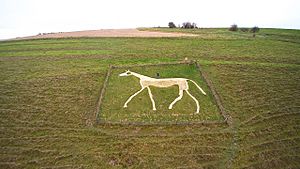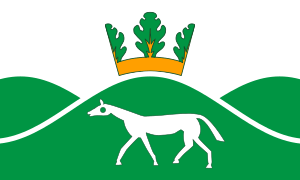Pewsey White Horse facts for kids
The Pewsey White Horse is a giant horse shape carved into a hill near the village of Pewsey, England. It's made from chalk and was created in 1937. This horse replaced an older one that had faded away. It's one of eight white horses still found in Wiltshire. At 66 feet long and 45 feet tall, it's the smallest of these famous Wiltshire horses.
When it was made, the Pewsey White Horse was one of the first new white horses in Wiltshire in the 1900s. George Marples designed it to celebrate the Coronation of George VI (when King George VI became king). He got his ideas from other white horses in the area.
Today, the Pewsey White Horse is a very well-known landmark in Pewsey. A group called the Pewsey 6X Club, also known as the Pewsey Horse Restoration Group, takes care of it. They keep it clean and bright. Experts say it looks like a "well-proportioned" (meaning well-shaped) real horse. The horse is so important that it's even on the official Town Flag of Pewsey. People describe it as standing in a "care-free trotting stance" and call it "one of Pewsey's proudest monuments."
How the Pewsey White Horse Began
A very old white horse was carved on the same hill before this one, probably in 1785. A man named Robert Pile, or someone he instructed, created it. Another nearby horse, the Alton Barnes White Horse, was made 27 years later by a Robert Pile from the same address. We don't know if it was the same person.
The old horse was cleaned in 1789. This was likely the first and last time it was cleaned. The landowner didn't like the parties that happened during the cleaning, so he didn't allow it again. Because of this, the horse was not cared for and slowly disappeared. By the mid-1800s, it was in bad shape. By the 1930s, you couldn't see the chalk anymore. However, you could still faintly see the outline of its head and body. You could see it as raised lines when the sun rose, or as a different color in the grass.
A drawing from 1939 shows that the old horse might have been well-shaped. There's a local story that the horse had a boy riding it. But people who saw the chalk in the late 1800s said there was no rider. So, this story is often thought to be untrue. If it had a rider, it would have been one of only two such horses in England. The other is the 19th-century Osmington White Horse near Weymouth.
In 1937, George Marples, an expert on hill figures, was studying the old, barely visible horse. At the same time, a group was formed to find a good way to celebrate the Coronation of George VI. Marples drew three designs for a new horse. They chose the design of a horse trotting to the left because it would be easier to maintain. The old Pewsey horse also faced left, as did all other Wiltshire white horses at that time. Marples suggested a special way to mark out the horse using triangles. A drawing of this method still exists.
Volunteers from the Pewsey Fire Brigade carved the horse in April 1937. Some reports say it was done in late April. The year '1937' was also carved above the horse. However, this date was never cleaned later, so you can't see it anymore. The horse was lit up with lights during coronation week. People said it looked "very good," except for two foggy nights. The nearby Cherhill White Horse was also lit up for the coronation. The Pewsey horse was carved 99 years after the Hackpen White Horse, which was made to celebrate the coronation of Queen Victoria. These are the only two horses in Wiltshire known to celebrate a coronation.
Where to Find the Pewsey White Horse
The Pewsey White Horse is the smallest white horse in Wiltshire. It is 35 feet tall and 67 feet long. It is carved on private land about a mile south of Pewsey Village. It's on a steep slope of Pewsey Hill, about 500 feet above sea level. Visitors can access the horse.
You can see the horse from the A345 road near Pewsey Village and from the south side of the village. But you can see it most clearly from the road between Pewsey and Everleigh, below Pewsey Hill. You can also visit the figure from the top of Pewsey Hill. There are footpaths leading to the horse and places to park a car, though they are not official parking spots.
Pewsey Hill is a chalk hill that marks one end of the 19-mile Vale of Pewsey. Other white horses are also found in this vale. The vale is part of the North Wessex Downs (Area of Outstanding Natural Beauty). The horse looks out over the Vale of Pewsey towards the Alton Barnes White Horse on Milk Hill. You can see the Pewsey White Horse from Milk Hill, near the Alton Barnes White Horse, but not from the exact spot of that horse.
The Pewsey White Horse is on the edge of Pewsey village. It is considered to be within the village's boundaries. It is the second public artwork in the village. The first was the King Alfred Monument (1913). This monument was put up in the village center to celebrate the coronation of King George V, who was King George VI's grandfather.
Looking After the Horse Today
Over time, the horse has become slightly larger. A fence surrounds the figure to stop animals from damaging it. This makes it one of four Wiltshire White Horses that are fenced in. The others are Alton Barnes White Horse, Cherhill White Horse, and Marlborough White Horse. Around 1999 or 2000, an information board was put up above the horse. It gives details about all eight white horses. This board was placed after the Devizes White Horse was carved. The edges of the horse are very clear, and the chalk is made of small, tightly packed pieces.
The Pewsey 6X Club, also known as the Pewsey Horse Restoration Group, maintains and cleans the horse. The horse is usually re-chalked (or 'scoured') every eight or ten years. One cleaning happened in November 1998, and another in spring 2004. The horse was cleaned again in 2017 by about 15 people to celebrate its 80th birthday. First, they cleaned the surface. Then, they removed weeds and moss with sharp hoes. Finally, they put fresh chalk on the horse. They pressed it down a little with hand tools, and then the rain finished the job. The Pewsey Parish Council thanked the volunteers with glasses of Prosecco.
In July 2008, Eqvalan, a brand of medicine for horses, helped protect the white horse. This was part of their 25th birthday celebrations. Their donation helped fix the protective fence around the horse. In return, Eqvalan was allowed to decorate the horse for a short time. They put a party hat on the horse and hung colorful flags inside the fence. More recently, the white horse was covered with grass before Pewsey's yearly carnival. Then, a model of the horse appeared in the carnival parade itself.
The Town Flag of Pewsey was officially registered on September 18, 2014. It features a drawing of the Pewsey White Horse in the middle. Eleanor Taylor designed the flag. The dark green hills on the flag show Pewsey's countryside. The White Horse is placed on these hills. Above the horse is a crown, which represents King Alfred. King Alfred has a statue in the village center, which is the only other public artwork in Pewsey besides the white horse. King Alfred once owned land in Pewsey. The oak leaves on the flag show how strong and solid the village is.





